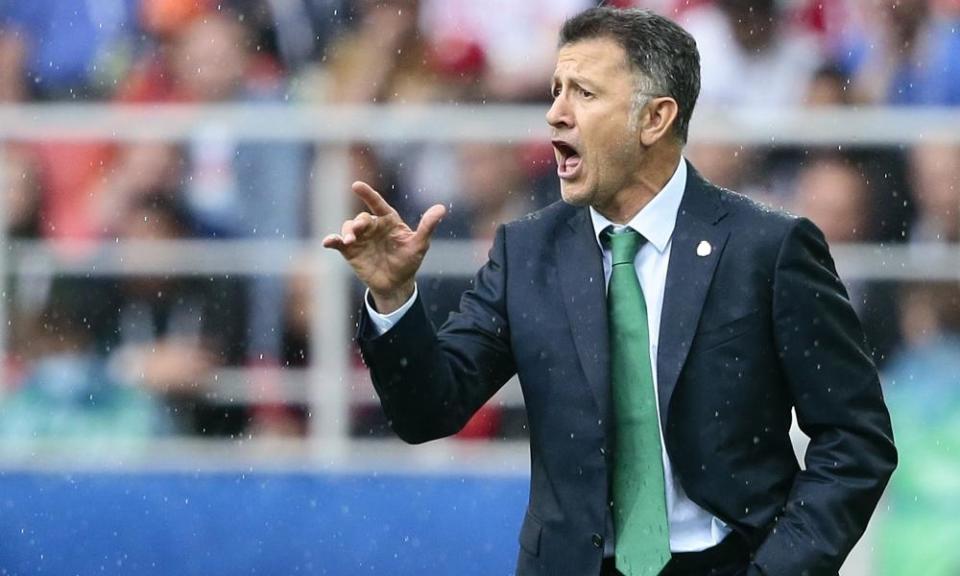How a stepladder, Liverpool and Man City helped educate Juan Carlos Osorio
The Mexico coach has always forged his own path. And that includes his time in England’s north-west building the foundations of his knowledge

Earlier this month, as the final whistle blew at the Azteca, the boos rang
out. Mexico had beaten Scotland 1-0 in their last home friendly before
leaving for the World Cup, but that was not enough. “Fuera, Osorio,”
fans chanted, calling for their manager to be sacked.
Juan Carlos Osorio himself seemed unconcerned, claiming not to have
heard the jeers. He is probably used to them. He may have won 31 of
his 47 games in charge of the national side, losing only seven, but he
has never been popular. He is different, his own man with his own
ideas, and it probably doesn’t help that he is not Mexican. Osorio has
always been something of an outsider – so much so that he is known as
El Recreacionista for his unorthodox approach. He may be Colombian and
he may be coach of Mexico, but the 57-year-old’s education was
thoroughly English.
Osorio was a midfielder for Internacional in Brazil and Once Caldas in
Manizales before injury ended his playing career at the age of 26. He
went to the US, where he played briefly for the University of New
Haven and then completed a BA in Exercise Science at Southern
Connecticut State University. He moved to New York and set up a gym,
but Osorio wanted to get back into football, so he sold his business
and used the proceeds to move to Liverpool to study for a diploma in
Science and Football at John Moores University. The lectures weren’t
enough, though, so Osorio would try to observe the training sessions
of the two local Premier League sides.
Walter Smith’s Everton were welcoming; Gerard Houllier and Roy Evans’
Liverpool were not, so Osorio rented a room in a house on Crown Road
owned by an Everton-supporting family called McManus that overlooked
Liverpool’s Melwood training ground. If the weather was good, he
would stand on a step-ladder in the garden; if it was raining he would
peer out of the bedroom window.
Osorio would also regularly go to watch Blackburn and Bolton. “Because
I came from a Latin country where everything was short passes and
tiki-taka, then coming to England learning the complete opposite way
of playing was very, very productive for me,” he said in an interview
with Sky. “And in itself, it has strengthened me a great deal.”
Osorio returned to the US and became a conditioning coach with New
York/New Jersey Metrostars, but in the summer of 2000, the Manchester
City assistant manager Willie Donachie brought in a conditioning
consultant called Mark Bellamy to assess the players’ fitness
programmes. Bellamy suggested a way of gaining an edge over wealthier
opponents who could afford larger transfer fees would be to appoint a
specialist, so City placed an advert in a trade magazine.
They received a number of applications, but the one that stood out
came from Osorio, whom Bellamy knew from their time at John Moores
University. He insisted Osorio be included on a three-man shortlist,
even though he had been unable to make it over for an interview.
“Near the end of the [2000-01] season,” Dennis Tueart, the City
director on the five-man panel making the appointment, remembers, “we
got those last remaining candidates – Juan Carlos, one from
Loughborough and one from Durham – in for a face-to-face interview,
and an outdoor and an indoor practical with members of the Academy. By
that stage everybody left was excellent, but what set Juan Carlos
apart was his football background.
“He managed to dress his sports science in a football language, and he
would, for instance, arrange specific sessions to work on the tiny
muscle at the top of the groin that’s key to sidefooting the ball; he
recognised that soft tissue injuries are a real problem for
footballers and had a range of ways of trying to prevent them. When
the committee members sat down after that, and we went round the
table, the other four were all in favour of Juan Carlos – as was I.”
Joe Royle was manager when Osorio was approached, but he was soon
replaced by Kevin Keegan. It was, though, Alex Ferguson who proved the
bigger influence. Keen to continue his education, and with ambitions
beyond conditioning, Osorio observed training sessions at Carrington
and would hang around for five minutes’ conversation with Ferguson. It
was from the Scot that he developed his theory of rotation, which seems to
go far beyond guarding against fatigue. At the Copa America Centenario
two years ago, Osorio used a different goalkeeper in each of the three
group games. That tendency to chop and change has underlain much of
the criticism he has received from Mexico fans but Osorio is adamant
that it is vital for everybody to feel involved.
Whether his methods work at international level remains to be seen,
but Osorio’s method has been successful in the club game, bringing an
MLS Western Conference title and four Colombian league titles as well
as two Copas de Colombia in the past decade. And if Mexico can reach
the World Cup quarter-final for the first time on foreign soil, a
little part of that success would have been born in the English
north-west.

